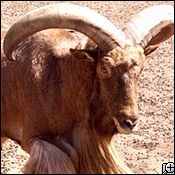Quck answer
Aoudad, also known as Barbary sheep, is a species of wild sheep native to North Africa. They have a distinctive appearance with long, curved horns and a shaggy coat that helps them survive in rocky, arid environments. Aoudads are social animals and live in herds of up to 24 individuals, led by a dominant male. They are herbivores, feeding on a variety of plants and grasses. Introduced to Texas and New Mexico in the 1950s, aoudads have become a popular big game species for hunting. While their populations remain stable in North Africa, aoudads are considered an invasive species in some parts of the United States.
Wild Animals

Aoudad
Amr Nabil/Associated Press |
The Barbary sheep is also known as Aoudad.
A dominant female leads family units of Aoudad which wander from place to place, foraging on grass, herbs, leaves, and twigs.
Aoudad is capable of rising on its hindlegs, like goats, to reach the foliage of dwarf acacias.
It can obtain most of its water from the plants it eats and by licking the dew off vegetation.
Aoudad is capable of leaping and bounding across the rocky terrain to escape its predators, the desert lynx and the leopard.
>>View the Main Menu<<
Animal Facts
Name: Aoudad (Ammotragus lervia)
Family: Bovidae (Cattle and Relatives)
Range: Isolated populations in northern Africa; introduced and established in United States
Habitat: Dry, rocky, barren regions of montane Sahara
Diet: Grass, forbs and shrubs
Head and Body Length: 4.3 to 6 feet (1.3 to 1.9 m)
Tail Length: 6 to 10 inches (15 to 25 cm)
Shoulder Height: 29.5 to 44 inches (75 to 112 cm)
Weight: 88 to 320 pounds (40 to 145 kg)
Life Cycle: Mating year-round, peaks vary by region; gestation 154 to 161 days, one or two young born
Description: Aoudad has a reddish-tawny coat, a mane on its neck and shoulders, long, white hairs on throat, chest and forelegs, and crescent-shaped horns.
Conservation Status: Vulnerable
Major Threat: Habitat loss and degradation; hunting
What Can I Do?: You can help by visiting the African Wildlife Foundation for more information.
FAQ
1. What is an Aoudad?
An Aoudad (Ammotragus lervia) is a species of goat-like mammal native to North Africa. It is also known as the Barbary sheep, waddan, or arui.
2. Where do Aoudads live?
Aoudads are found in the rocky mountainous regions of northern Africa, including the Atlas Mountains, the Ahaggar Mountains, and the AГЇr Mountains. They have also been introduced to other parts of the world for hunting purposes.
3. What do Aoudads eat?
Aoudads are herbivores and primarily feed on grasses, herbs, and leaves. They are also capable of browsing on shrubs and trees.
4. How big can Aoudads get?
Aoudads are a medium-sized mammal, with males weighing between 110-140 pounds and females weighing between 80-110 pounds. They can grow up to 3-4 feet tall at the shoulder.
5. What is the lifespan of an Aoudad?
In the wild, Aoudads can live up to 12-15 years. In captivity, they can live up to 20 years.
6. Are Aoudads endangered?
No, Aoudads are not considered endangered. However, their populations have declined in some areas due to hunting and habitat loss.
7. How do Aoudads defend themselves?
Aoudads have thick, curved horns that they use to defend themselves against predators. They also have keen eyesight and are able to detect predators from a distance.
8. Do Aoudads live in groups?
Yes, Aoudads are social animals and typically live in groups of 10-30 individuals. The groups are usually led by a dominant male.
9. Can Aoudads be domesticated?
Yes, Aoudads have been domesticated in some parts of the world for their meat and milk.
10. Are Aoudads hunted for sport?
Yes, Aoudads are a popular game animal and are hunted for sport in many parts of the world. However, hunting regulations and restrictions are in place to ensure sustainable hunting practices.





Leave a Reply